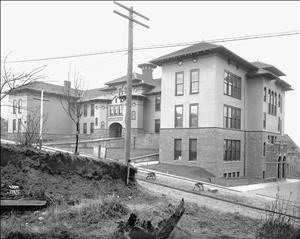This history of Summit School is taken from the second edition of Building for Learning: Seattle Public School Histories, which includes histories of every school building used by the district since its formation around 1862. The original essay was written for the 2002 first edition by Nile Thompson and Carolyn J. Marr, and updated for the 2024 edition by HistoryLink contributor Ryan Anthony Donaldson.
On First Hill
In 1904, the Seattle School District purchased the site of old Grace Hospital on Summit Avenue near the top of First Hill, overlooking downtown Seattle and Elliott Bay. The surrounding neighborhood had many substantial homes built by the city’s wealthier citizens, as well as a few recently built apartments. Centrally located, the school’s future expansion was restricted by the small size of its lot.
The Summit School was named for its street location. Its building, designed by Seattle School District architect James Stephen, differed from his usual “model school” plan, which allowed for expansion in stages. Rather, Summit’s floor plan, along with its stucco exterior finish and Mission Revival-style parapets, was unique within the district.
Summit School was crowded during its first year of operation, 1905-1906. In addition to the 420 pupils in grades 1-6, it housed an annex to Seattle High School with 455 students. In fall 1906, the High School Annex moved to Franklin School, and 7th and 8th grades were added in their place. Because there was so little room on the grounds, the older boys used a gravel pit across the street for their playground. The only major addition to the original building was the construction in 1914 of two additional classrooms. To achieve this, two little-used lavatories on the east side of the building were removed and the ground excavated, thereby preserving space for a new playroom. In 1917, the district considered obtaining the five lots west of the school property but decided against the purchase. A kindergarten began in 1920. In 1928, a gymnasium was added to the north side.
The neighborhood surrounding Summit gradually became more commercial. The district found the site too small for an intermediate school, and a 1923 report suggested that Summit be made the home of programs focusing on children with special needs. The school continued to serve as an elementary school for the next 42 years in addition to housing special education programs.
From 1926-1930, Summit housed the Demonstration School, where district teachers observed superior staff at work, thereby learning from their peers. The program moved to Seward in 1931 because of declining enrollment at Summit. The School for the Deaf moved from Minor to Summit in 1940. Forty-six children who were totally deaf from birth were taught to speak and “to read words on the lips of others.” The program moved to University Heights in 1955. In 1960, an intermediate pre-adjustment class transferred to Bailey Gatzert to make room for a library.
Diversity
In 1964-1965, Summit ranked second among Seattle’s elementary schools in terms of combined percentage rankings for five ethnic groups (10th for African Americans, first for American Indians, 12th for Filipino Americans, fifth for Chinese Americans, and fifth for Japanese Americans), with whites forming 44.1 percent of the student body. In the early 1960s, enrollment at Summit had declined to about 200 students, and in 1965 it was closed as an elementary school. Summit’s ethnically diverse student body dispersed to other schools, including Bagley, Interlake, McDonald, and Greenwood.
Seattle Community College used the building for college transfer classes from 1965 until 1973, prior to the expansion of the central campus. The district decided in 1967 to retain ownership of Summit rather than transfer it to the state as part of the community college. Instead, the building was leased to the college.
From 1974 until 1977, the basement of Summit housed alternative programs. For a year, the Nova program was housed at Summit before it was relocated to Horace Mann. Until the building was sold in 1977, the Summit School, an alternative school for students in grades 9-12 that began as an offshoot of the Nova Program, was also housed at Summit. The Summit School emphasized informal classes, group projects, and the use of community resources. Its 100 students came from all over the city. Facing the immediate sale of the Summit building, the Summit program moved to Mann, where it resided for two years, before relocating to Colman.
The school district sold the Summit building to a developer, who converted it into an office complex in 1977, the same year it was listed on the National Register of Historic Places. In September 1980, Summit once again opened its doors to students, this time as The Northwest School, a college preparatory and boarding school for grades 6-12.
History
Summit School
Location: 1415 Summit Avenue
Building:16-room wood frame with stucco
Architect: James Stephen
Site: .68 acres
1905: Opened as elementary school
1905-06: Housed annex to Seattle High School
1914: Addition (n.a.)
1928: Addition (n.a.)
1965: Closed as elementary school
1965-1973: Annex to Seattle Community College
1974-1977: Alternative school site
1977: Sold to developer; placed on National Register of Historic Places
1980: Opened as the Northwest School
1997: Purchased by Northwest School of the Arts
Present: Site of Northwest School

